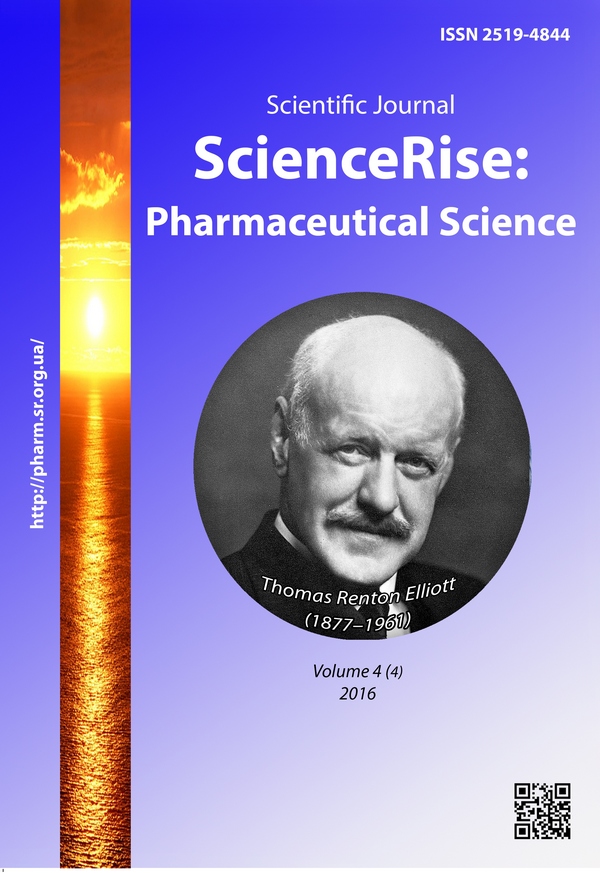Technological studies on the development of the corrected dosage form base
DOI:
https://doi.org/10.15587/2519-4852.2016.87540Keywords:
combined syrup, base, thickeners, excipients, herbal compound, composition, technologyAbstract
Aim. The aim was to substantiate and to study excipients, in particular thickeners, in development of the base composition of the combined syrup containing herbal compound, applied for the treatment of hepatobiliary system and gallbladder.
Methods. Analytical, retrospective, logical methods were used for the literature data analysis; marketing analysis – for research of the national market pharmaceutical segment in relation to excipients in syrups studies; physical and organoleptic methods.
Results. According to the given research results, substances, used as excipients in syrups production and registered in Ukraine, were determined. It was found, that saccharose (38%), as well as sorbitol and lactulose (19% each), and among synthetic compounds Sodium saccharin (13%) are most commonly used as sweeteners in syrups. Moreover, the use of saccharose in syrups by the national manufacturers far exceeds its use by the international producers (75% and 25%, respectively). The most commonly used thickeners are cellulose derivatives (HEC and CMC – 60% and 34%, respectively) and gums (23%). Only 25% of the national manufacturers use thickeners as excipients.
Results have shown that the samples 3 and 4 with HEC concentration 0,3 and 0,4% had poor consistency as for syrup. Syrup sample 5 (with HEC content 0,5 ± 0,2 %) is a viscous liquid, which is dosed easily, with mass dosing deviation no more than ± 3 %, that meets the SPhU requirements. Therefore, according to the dynamic viscosity and organoleptic properties indexes, the concentration of hydroxyethyl cellulose was determined for the developed syrup – 0,5 ± 0,1 %.
Conclusion. The advisability of using of the thickener – hydroxyethyl cellulose in concentration of 0,5% – in the combined syrup development was theoretically substantiated and experimentally provedReferences
- Derzhavna Farmakopeja Ukraini (2001). Derzhavne pidpriemstvo «Naukovo-ekspertnij farmakopejnij centr». Kharkiv: Rireg, 520.
- Sineva, T. D. (2008). Farmakologicheskie aspekty primenenija sorbita v kachestve vspomogatel'nogo veshhestva v lekarstvennyh preparatah dlja detej. Voprosy biologicheskoj, medicinskoj, i farmacevticheskoj himii, 2, 41–45.
- Nikolova, E. (2013). Cultivation of natural sweetener stevia (stevia rebaudiana b.) in central bulgaria – plovdiv region. New knowledge journal of science, 207–216.
- Shmal'ko, A. A., Vishnevskaja, L. I., Megalinskij, V. A. (2015). Issledovanija po vyboru nesaharnoj osnovy dlja rastitel'nogo siropa. Respublikanskij nauchnyj zhurnal «Vestnik», 4 (73), 116–119.
- Kuznecov, A. V., Kuznecov, A. A. (2011). Korrigenty vkusa v proizvodstve lekarstvennyh preparatov. Farmacija, 2, 53–57.
- Percev, І. M., Dmitrіevs'kij, D. І., Ribachuk, V. D. (2010). Dopomіzhnі rechovini v tehnologіi lіkіv: vpliv na tehnologіchnі, spozhivchі, ekonomіchnі harakteristiki і terapevtichnu efektivnіst. Kharkiv: Zolotі storіnki, 600.
- Zhoglo, F., Voznjak, V., Popovich, V., Bogdan, Ja. (1996). Dopomіzhnі rechovini ta ih zastosuvannja v tehnologіi lіkars'kih form. Lvіv, 95.
- Kamaeva, S. S., Merkureva, G. Ju., Stepanov, D. V. (2012). Razrabotka siropa ambroksola: vybor vspomogatel'nyh veshhestv. Zdorov'e – osnova chelovecheskogo potenciala. Problemy i puti ih reshenija, 7 (2), 846–848.
- Ahmed-Belkacem, A., Ahnou, N., Barbotte, L., Wychowski, C., Pallier, C., Brillet, R. et. al. (2010). Silibinin and Related Compounds Are Direct Inhibitors of Hepatitis C Virus RNA-Dependent RNA Polymerase. Gastroenterology, 138 (3), 1112–1122. doi: 10.1053/j.gastro.2009.11.053
- Coon, J. T., Ernst, E. (2004). Complementary and alternative therapies in the treatment of chronic hepatitis C: a systematic review. Journal of Hepatology, 40 (3), 491–500. doi: 10.1016/j.jhep.2003.11.014
- EASL Clinical Practice Guidelines: Management of cholestatic liver diseases (2009). Journal of Hepatology, 51 (2), 237–267. doi: 10.1016/j.jhep.2009.04.009
- Bray, G. A., Nielsen, S. J., Popkin, B. M. (2004). Consumption of high-fructose corn syrup in beverages may play a role in the epidemic of obesity. The American Journal of Clinical Nutrition, 79 (4), 537–543.
- European Pharmacopoeia (2004). Council of Europe. Strasbourg, 4800–4801.
Downloads
Published
How to Cite
Issue
Section
License
Copyright (c) 2016 Олександр Олександрович Шмалько, Лілія Іванівна Вишневська, Володимир Костянтинович Яковенко, Юрій Георгійович Пісковацький

This work is licensed under a Creative Commons Attribution 4.0 International License.
Our journal abides by the Creative Commons CC BY copyright rights and permissions for open access journals.








